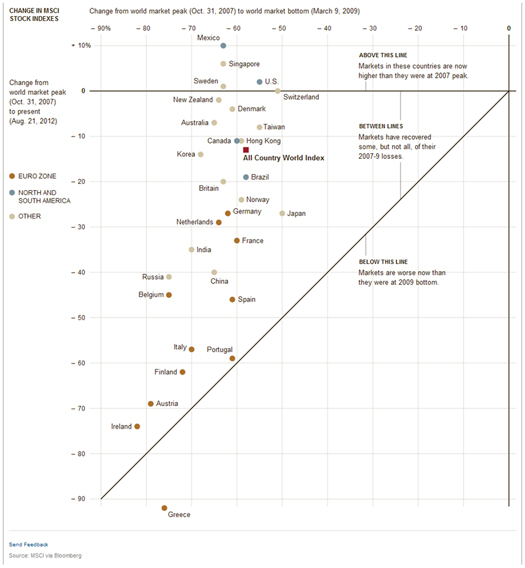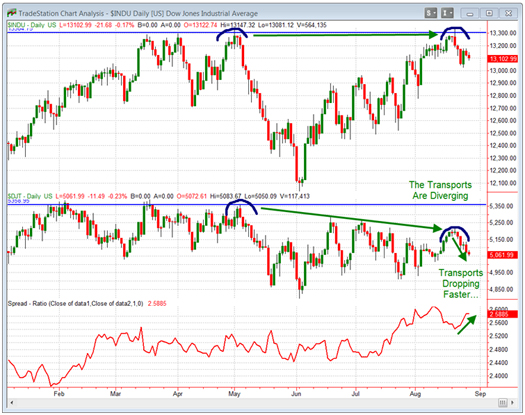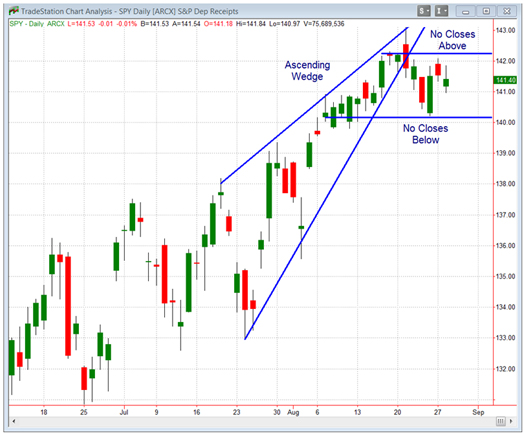Tharp's Thoughts Weekly Newsletter (View On-Line)
-
Article An Interview with Ken Long by R.J. Hixson and Ken Long
-
-
TradingTip Equities Markets: Longer-Term, Intermediate-Term and Shorter-Term by D.R. Barton, Jr.
Learn what makes Ken Long tick in this week's interview below.
Ken will be presenting two workshops this September:
Mechanical Day and Swing Trading, September 21-23, Fri-Sun
Discretionary Swing and Day Trading, September 24-28, Mon-Fri
Click Here to Learn More.
 An Interview with Ken Long An Interview with Ken Long
by R.J. Hixson and Ken Long
Ken Long is a successful trader, prolific system developer and outstanding instructor. His statistical and systematic approach to trading lends itself to profitable mechanical trading systems whose performance he has improved further through the judicious application of discretion. The systems Ken will teach in September at his Mechanical and Discretionary workshops are some of the highest SQN scoring trading systems Van has seen. We recently talked with Ken about his development as a trader, insights about trading psychology, systems, and what he sees in the current markets.
Q. How long have you been day trading now, and how did you start?
I’ve been trading for over 20 years. I started off with companies in sectors I was already trading on longer-term systems, and I wanted to improve my entries and exits on the signal day.
Q. How would you say your trading has changed over those years?
I think I've become both more systematic and more comfortable with my discretion. One thing that has really shaped my development is teaching. As I’ve become a better teacher, I’ve become a better trader. The more transparent I am about what I've done as a teacher and trader, the better my performance.
Q. Does psychology still affect your trading?
It remains by far the most important single component in everything I do. It's deeply embedded in my personal and family goals and objectives, the types of systems I design, the way I study and teach them, and the way I trade them in the moment. How I trade is tied to who I am—which is the central focus of psychology. Trading is craft and knowledge put into practice, and psychology is deeply involved in the sense-making that goes along with that. The journey toward mastery is a psychological one.
Q. You talk a lot about how you use statistics to inform you about the market and your trading, but not to make predictions. Why not?
There's plenty of evidence that markets are not normally distributed. Taleb and Mandelbrot describe the problems with using statistics to predict the behavior of nonlinear, power-law distribution processes. Too much faith in the predictive power of statistics can lead you to engineer all the slack out of your system, which would set you up for disaster when a fat tail event occurs. I’m careful to use statistics only to describe what has happened in order to define the range of normal behavior, to identify the boundary between rational and irrational exuberance, and to ensure I’m protected against adverse large-tail events.
Q. Does someone have to understand statistics to trade your systems well?
It helps, but it’s not absolutely necessary. I think Dr. Michael Starbird's course on statistics from the Teaching Company does an admirable job of relating statistics to everyday life and should be part of every person’s mental toolbox.
Q. How much experience does someone need to trade your systems?
I believe in making my systems as simple as possible, so they’re actually designed to be traded by novices. Simplicity is a quality of the rules set. But simple systems can be difficult to trade for psychological reasons, especially if the rules you're trying to trade don’t match your beliefs or don't make sense to you in light of your personal experience. I believe that your experience is useful to the extent that you reflect, analyze and learn legitimate lessons from it. Without reflection and analysis, experiences are shaped by our cognitive biases into untrustworthy memories. I like the saying, “perfect practice makes perfect.” If you begin your trading career with guided experiences in a framework that supports objective analysis, you can accelerate your learning curve.
Q. How much money does someone need to trade your systems?
Some of my shorter-term systems can be traded with as little as $5,000 in a futures account, and I believe the swing and longer-term systems need a minimum of $25,000 in order to take enough signals, because they often come in clusters.
Q. Are your mechanical systems really mechanical? Are they automated, or automate-able?
Each of my baseline systems can be traded mechanically. In fact, we hired one of the best Tradestation programmers in the world to completely automate six of my swing trade systems and the optional continuation pattern rule set that applies to all six. Because good programmers demand precise definitions, we refined the rules into a purely mechanical form. My long-term systems can also be traded purely mechanically, and different forms of my intraday Frog strategy can be traded mechanically. I'm constantly searching for ways to turn my intuitions about edges I think I see into rule sets that can be tested objectively. The learning process of turning discretionary trading into rule-based systems has improved both dimensions of my trading. This week, we completed automating my favorite long-term system to the Tradestation platform, which takes advantage of new, expanded backtesting and system refinement capabilities. I'm very excited about these packages.
Q. Will there be any changes to next month’s Mechanical Swing and Day Trading Workshop?
I'll be placing much more emphasis on worked examples and case studies to make sure that students get a chance to demonstrate their understanding of the concepts by practicing. The research I've been doing on experiential learning convinces me that this is the best way to transfer craft knowledge to others.
Q. At the recent Frog Boot Camp, you were talking about how the framework of the Frog system has helped you develop a new system called RLCO. How did that evolve?
The Frog system is based on defining the difference between signal and noise on intraday time frames. From there, I began to use descriptive statistics to frame intraday opportunities in a systematic, adaptive and disciplined way that relies on math and not on my judgment. The Frog minimizes the information you need to make decisions. When I saw that reducing the amount of information could still produce good trading, it made me very choosy about adding indicators back onto my chart. I like regression lines because they combine the insights of moving averages and the discipline of descriptive statistics. Combining the Frog with regression lines gives me a framework to pinpoint important critical states in different time frames. I think of critical states as moments when the market is under tension and ready to make a larger-than-normal move in either direction. This favors a direction-neutral trader and removes the pressure to be right about direction.
Q. Will your experience at the recent Frog Boot Camp affect the September Mechanical or Discretionary workshops?
The Frog Boot Camp reminded me just how hard it is to express simple rules simply, and how hard it is to follow those rules when your own experience is whispering in your ear. Consequently, I'm going through my rules again to make sure I’m as clear as I can possibly be about the concepts. I’ll also make sure we have case studies to practice on.
Q. We know you love coaching your daughter’s soccer team as much as you love trading. Has coaching helped your trading in any way?
There's a saying among soccer coaches that the ball will bounce the way it will bounce regardless of your plans. The best soccer players combine preparation, conditioning and a robust game plan but retain the ability to adapt to surprises they find on the field. My daughter's team excels because of their teamwork and preparation, and those are qualities I prize in our trading mastermind as well.
Q. In your mastermind and at your workshops, you advocate keeping a trading journal. Why do you find them so useful?
We have so many cognitive biases that I think it's better to document, understand and protect against them than to try to eliminate them, which is basically like trying to eliminate human nature. Because psychology is so important to trading, the learning journal addresses those parts of the story not told by charts and patterns.
Q. What needs to be in a trading journal?
There are several things. You should include the key price information that allows you to generate an R-multiple calculation for the trade; the key decisions of each trade, with a snapshot of what was going on at the time; a rich description of your internal states; justifications for changing your rules if you do change them; an evaluation of your performance against your rule set as part of your daily debrief; an area for reflective thinking, which helps you make sense of your experiences; an area for committing to a particular action in writing; and comments on the results of your actions.
Q. Do you have traders at the live Discretionary workshop keep a trading journal?
Absolutely. I consider that to be the most important part of the workshop. If you can follow through with the learning journal, trading the systems are relatively easy. Holding an honest mirror to yourself and looking at your performance, warts and all, is much more difficult than following some rules. If you can’t do that, you probably don’t have the emotional resilience to be a trader.
Q. Your Discretionary workshop doesn’t teach a completely discretionary approach. How would you describe what you do there?
I consider myself to be a systematic trader with discretionary tendencies. I use systems, rules and statistics to define the space where I can use my discretion. My decision framework is based on backtesting and math to make sure that I’m trading in an area where I have an identifiable edge. The more advantages I can accumulate for my trading area, the better off I am. Basically, I'm looking for a minimum reward-to-risk ratio of 2 to 1 so that my discretion has an opportunity to succeed, and I compare my discretionary performance against a straightforward application of the mechanical rules to make sure that the discretion is adding value. I think you have a chance to get the best of both worlds if you systematically look at both mechanical rules and discretion.
Q. Do you have any thoughts on what the market is doing right now? (note—answered on 8/22/2012)
I look at three different time frames to make that judgment. Here's what I see.
- Long term (months or longer): I classify the market as bull quiet, with 100% risk exposure to global equity markets based on the world market model. We’re not yet oversold long-term, but were getting close to one-year and four-year highs. That's produced strong resistance in previous cycles, so I'm alert to the possibility that the intermediate trend may experience significant change. The U.S. large-cap value sectors have been strong for six months, but there's evidence of resurgence in the risk-on technology trade, as well as a shift in some global opportunities. Gold and silver are making stealthy bases and starting to show some strength.
- Swing term (days and weeks): We’ve just come out of overbought conditions on the 10-day basis. The regression channel is up, but not dangerously so. Volatility is remarkably quiet. A break above 142 in SPY would be very favorable because the next resistance levels are near 150, but a break below 138 would set up a test of the bottom of the regression channel near 132; consequently, a tactical swing trade in either direction would be perfectly natural. This is great for a short-term trader because there's a strong argument for a 5%-to-8% move in either direction.
- Intraday: This is defined purely by my Frog and regression-line statistics. We have plenty of tradable symbols in either direction across multiple market sectors and geographical regions, which gives us lots of intraday trading opportunities without overnight risk.
Q. Do you have an opinion on high-frequency trading? Is it affecting the markets, good or bad? Does it affect the way you trade?
It’s certainly accounting for a significant amount of volume. Because it's rule-based, there's evidence of intraday patterns that kick in quickly and trap the unwary. I think it gives statistical traders an edge because algorithms don't have to have a human belief to trigger them. Sudden sharp moves favor the agile, as well as those who know how to leave the party before it's too late. HFT is the current favorite whipping boy for all things difficult in the market, but it can't possibly be to blame for all the things that people attribute to it.
Q. Can you tell us how your trading is evolving into the next state?
As I reflect more and more on my ideas for refining, expanding and integrating my systems, those ideas come faster and faster. I've learned from Van not only how to identify and change beliefs, but how to eliminate the need for them, or at least some of them. This creates a free space in which I can quickly explore ideas from all angles without preconceived notions of what to expect. That's opened me up to receive insights from many unexpected directions, insights I’ve been able to translate into effective systems. The mastermind has also moved my trading to new levels because it gives me the opportunity to work and play with traders who are committed to each other's success.
About the Author: Ken Long retired from the Army as a Lieutenant Colonel and now teaches at the U.S. Army Staff College. He recently earned a D.M. in Organizational Behavior. He is a proud father of three, a husband, teacher, student, martial artist and active trader. Ken also instructs dynamic trading workshops for the Van Tharp Institute.
Disclaimer
Trading Education
Workshops
September 8-9
$250 |
Sensory Enlightenment Weekend with an American Buddha
With Stuart Mooney (Only a few seats remain) |
September 21-23
$3,295 |
Mechanical Systems for Day and Swing by Ken Long
Featuring Highly Profitable Short-Term Systems for Frequent and Profitable Trades!
Learn six strategies in three days. Click here to learn more about these strategies. |
September 24-28
Prices vary per day |
Discretionary Live Trading by Ken Long
Coaching and demonstration of what to do in preparation for the trading day, trading during market hours, and how to recap the lessons for the day after market close. Learn more... |
October 6-7
$195 |
Oneness Awakening Workshop
Learn ancient meditation practices to help open and balance your mind and spirit. |
October 19-21
$2,295 |
Peak Performance 101
Van Tharp's Signature Workshop |
October 23-26
$3,295 |
Peak Performance 202
with Van Tharp and Dr. Libby Adams |
November 9-11
$3,295 |
Forex Trading Systems
Presented by Gabriel Grammatidis |
November 13-15
Prices vary per day |
New! Great Super Trader Systems
Intraday • Automated Swing • Bear Recovery |
To see our full workshop schedule, including dates, prices and location, click here.
Trading Tip
 Equities Markets: Equities Markets:
Longer-Term, Intermediate-Term and Shorter-Term
by D.R. Barton, Jr.
Today, we’re going to jump straight into our topic, because I have three visuals to share with you and precious little space to do it! Last week (click here), we talked about how interesting Tuesday (8/21) was as a key reversal range-expansion day. This week, we’ll build on those components as we take a look at equities across three time frames.
Longer-Term Look: Cool Graphic Alert!
Long-suffering readers of my articles know that I really love compelling visuals, so I want to show you a graphic that the New York Times published on Friday of last week. It shows that the U.S. equities markets (as measured by the MSCI index) are among only four that have eclipsed their 2007 highs. The only major U.S. index that is currently higher than its 2007 high is the NASDAQ, which is an astonishing 25% above its 2007 highs—thanks mostly to Apple, which is a whopping 3.37 TIMES higher than it ever got in 2007!
The graph needs a little explanation. The X-axis (going left to right) shows how big the 2007-2009 drop was for each country on a percentage basis. The Y-axis (top to bottom) shows current price as a percent of price on October 31, 2007. Any MSCI country index above the “0” line is above the 2007 peak level.

View Larger Image
As you can see, only Mexico, Singapore, Sweden and the U.S. have bettered their 2007 highs. Most of Europe and the BRIC countries (except Brazil) continue to struggle mightily. How long can the U.S. markets continue to push higher with many of the important world markets failing to gain traction?
Intermediate Time Frame: Dow Theory Perspective
The father of modern technical analysis, Charles Dow, believed that the industrial sector and transportation sector must confirm moves. The chart below shows the retest of the high earlier this year in the industrials but no test in the transports:

In short, the transports’ non-confirmation doesn’t bode well for the upside breakout players. On the other hand, if we go up for a true retest of last week’s yearly highs, watch to see if the transports can make up significant ground relative to the industrials. That would be the only way to turn this currently bearish relationship to the upside.
Shorter-Term Time Frame: Illuminating Chart Patterns
In the shorter term, the SPY broke its ascending wedge (a bearish pattern) to the downside and is now consolidating in a sideways pattern:

Chances are that this market will continue the break to the downside, but, as mentioned above, it wouldn’t come as a big surprise if price were to stretch up and test last week’s highs before doing so.
Very Near-Term
This week will probably be somewhat directionless as the world waits for Ben Bernanke’s speech on Friday in Jackson Hole, Wyoming (the venue he chose two years ago to announce QE2). That speech is the most likely catalyst for the market’s next directional push.
As always, I welcome your thoughts and comments! Please send them to drbarton “at” vantharp.com.
Great Trading, D. R.
About the Author: A passion for the systematic approach to the markets and a lifelong love of teaching and learning have propelled D.R. Barton, Jr. to the top of the investment and trading arena. He is a regularly featured guest on both Report on Business TV and WTOP News Radio in Washington, D.C., and has been a guest on Bloomberg Radio. His articles have appeared on SmartMoney.com and Financial Advisor magazine. You may contact D.R. at "drbarton" at "vantharp.com".
Disclaimer
 Special Reports, Self-Sabotage Reexamined Special Reports, Self-Sabotage Reexamined
$19.95 Ea
Special, Buy One Get One Free
Ask Van...
Everything we do here at the Van Tharp Institute is focused on helping you improve as a trader and investor. Consequently, we love to get your feedback, both positive and negative!
Click here to take our quick, 6-question survey.
Also, send comments or ask Van a question by clicking here.
Back to Top
Contact Us
Email us at [email protected]
The Van Tharp Institute does not support spamming in any way, shape or form. This is a subscription based newsletter.
To change your e-mail Address, click here
To stop your subscription, click on the "unsubscribe" link at the bottom left-hand corner of this email.
How are we doing? Give us your feedback! Click here to take our quick survey.
800-385-4486 * 919-466-0043 * Fax 919-466-0408
SQN® and the System Quality Number® are registered trademarks of the Van Tharp Institute
Back to Top |